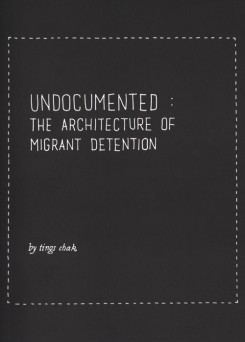Paperback, 111 pages
English language
Published Jan. 6, 2014 by Architecture Observer.

Paperback, 111 pages
English language
Published Jan. 6, 2014 by Architecture Observer.
"This thesis explores migrant detention centres in Canada, the fastest growing incarceration sector in North America's prison industrial complex, and questions the role of architectural design in the control and management of migrant bodies in such spaces. Migrants are detained primarily because they are undocumented. Likewise, these sites of detention bare little trace -- drawings and photos are classified; access is extremely limited. The detention centres, too, are undocumented. The purpose of this investigation is to make visible the sites and stories of detention, to bring them into conversations about our built environment, and to highlight migrant detention as an architectural problem. Through the loosely defined medium of the graphic novel, this thesis presents an architectural tour of the genericized migrant detention centre. Using the conventional architectural tools of representation -- plan, section, axonometric and perspective drawings -- presented sequentially and accompanied by text, we confront the silenced voices of …
"This thesis explores migrant detention centres in Canada, the fastest growing incarceration sector in North America's prison industrial complex, and questions the role of architectural design in the control and management of migrant bodies in such spaces. Migrants are detained primarily because they are undocumented. Likewise, these sites of detention bare little trace -- drawings and photos are classified; access is extremely limited. The detention centres, too, are undocumented. The purpose of this investigation is to make visible the sites and stories of detention, to bring them into conversations about our built environment, and to highlight migrant detention as an architectural problem. Through the loosely defined medium of the graphic novel, this thesis presents an architectural tour of the genericized migrant detention centre. Using the conventional architectural tools of representation -- plan, section, axonometric and perspective drawings -- presented sequentially and accompanied by text, we confront the silenced voices of those who are detained and the anonymous individuals who design spaces of confinement"--Author's website.